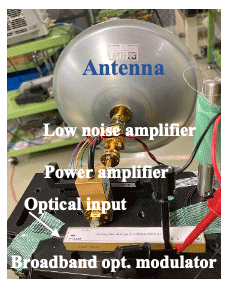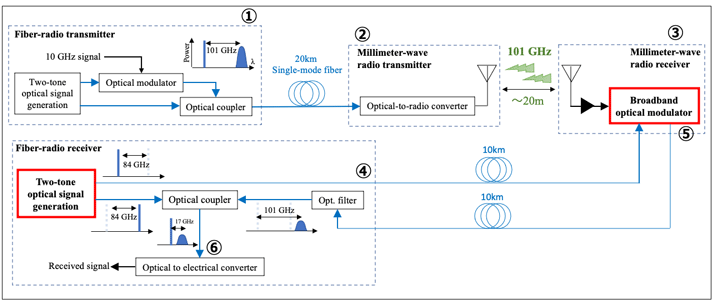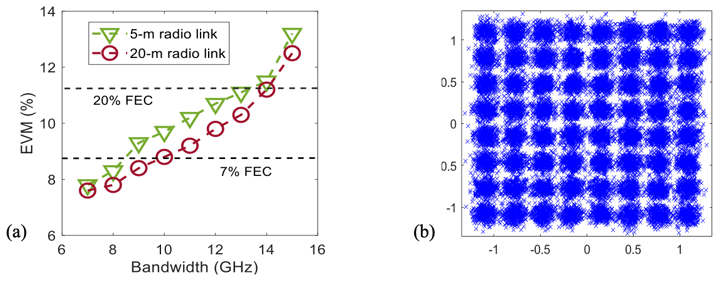Fig. 4 shows a schematic diagram of the proposed system, which includes six main parts: a fiber-radio transmitter, a millimeter-wave radio transmitter, a millimeter-wave radio receiver, a fiber-radio receiver, millimeter-wave-to-optical conversion, and signal down-conversion and detection.
(1) Fiber-radio transmitter
This block generates and modulates signals. A two-tone optical signal with a frequency separation of 91 GHz was generated using optical modulation technology. The two optical sidebands were separated, and one of them was modulated by a 10 GHz radio signal. The bias voltage to the modulator was controlled to generate only the upper modulation sideband. The modulated and unmodulated sidebands were combined to form a 101-GHz radio-over-fiber (RoF) signal.
(2) Millimeter-wave radio transmitter
After transmitting over a 20-km single-mode fiber, the RoF signal was up-converted to a 101-GHz millimeter-wave radio signal using a high-speed photodetector. The generated radio signal was emitted into free space using a millimeter-wave antenna.
(3) Millimeter-wave radio receiver
The millimeter-wave signal was received by another millimeter-wave antenna, amplified, and converted to an optical signal using the developed high-speed optical modulator.
(4) Fiber-radio receiver
Another two-tone optical signal with a frequency separation of 84 GHz between the two sidebands was generated. One of the sidebands was transmitted to a millimeter-wave radio receiver for data modulation.
(5) Millimeter-wave-to-optical conversion
The optical carrier signal generated at (4) was modulated by the 101 GHz millimeter-wave signal obtained from (3), and the bias voltage to the modulator was controlled to generate a double-sideband suppressed carrier signal. The modulated signal was transmitted to the fiber-radio receiver using a 10-km single-mode fiber link.
(6) Signal down-conversion and detection
One of the modulated sidebands from (5) was selected using optical filtering and combined with the unmodulated sideband of the generated two-tone optical signal from (4) to form an RoF signal with a center frequency of 17 GHz (= 101-84GHz). The signal was converted to a microwave band signal using a low-speed photodetector.





 ml.nict.go.jp
ml.nict.go.jp